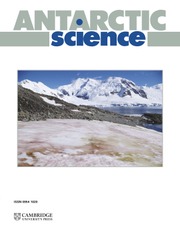Crossref Citations
This article has been cited by the following publications. This list is generated based on data provided by
Crossref.
Dirks, P.H.G.M.
Hoek, J.D.
Wilson, C.J.L.
and
Sims, J.
1994.
The Proterozoic deformation of the Vestfold Hills Block, East Antarctica: implications for the tectonic development of adjacent granulite belts.
Precambrian Research,
Vol. 65,
Issue. 1-4,
p.
277.
Hand, M.
Wilson, C. J. L.
Scrimgeour, I.
Stüwe, Kurt
and
Arne, D.
1994.
Geological observations in high‐grade mid‐Proterozoic rocks from Else Platform, northern Prince Charles mountains region, east Antarctica.
Australian Journal of Earth Sciences,
Vol. 41,
Issue. 4,
p.
311.
Zhao, Yue
Liu, Xiaohan
Song, Biao
Zhang, Zongqing
Li, Jiliang
Yao, Yupeng
and
Wang, Yanbing
1995.
Constraints on the stratigraphic age of metasedimentary rocks from the Larsemann Hills, East Antarctica: possible implications for Neoproterozoic tectonics.
Precambrian Research,
Vol. 75,
Issue. 3-4,
p.
175.
Hensen, B. J.
and
Zhou, B.
1995.
A Pan‐African granulite facies metamorphic episode in Prydz Bay, Antarctica: Evidence from Sm‐Nd garnet dating.
Australian Journal of Earth Sciences,
Vol. 42,
Issue. 3,
p.
249.
Dirks, P.H.G.M.
and
Wilson, C.J.L.
1995.
Crustal evolution of the East Antarctic mobile belt in Prydz Bay: continental collision at 500 Ma?.
Precambrian Research,
Vol. 75,
Issue. 3-4,
p.
189.
Hopgood, A.M.
and
Bowes, D.R.
1995.
Matching Gondwanaland fragments: the significance of granitoid veins and tectonic structures in the Cape Leeuwin—Cape Naturaliste terrane, SW Australia.
Journal of Southeast Asian Earth Sciences,
Vol. 11,
Issue. 3,
p.
253.
Groenewald, P.B.
Moyes, A.B.
Grantham, G.H.
and
Krynauw, J.R.
1995.
East Antarctic crustal evolution: geological constraints and modelling in western Dronning Maud Land.
Precambrian Research,
Vol. 75,
Issue. 3-4,
p.
231.
Dirks, P. H. G. M.
and
Hand, M.
1995.
Clarifying temperature‐pressure paths via structures in granulite from the Bolingen Islands, Antarctica.
Australian Journal of Earth Sciences,
Vol. 42,
Issue. 2,
p.
157.
Carson, C. J.
Hand, M.
and
Dirks, P. H. G. M.
1995.
Stable coexistence of grandidierite and kornerupine during medium pressure granulite facies metamorphism.
Mineralogical Magazine,
Vol. 59,
Issue. 395,
p.
327.
Carson, C. J.
Dirks, P. G. H. M.
Hand, M.
Sims, J. P.
and
Wilson, C. J. L.
1995.
Compressional and extensional tectonics in low-medium pressure granulites from the Larsemann Hills, East Antarctica.
Geological Magazine,
Vol. 132,
Issue. 2,
p.
151.
Moyes, A.B.
and
Groenewald, P.B.
1996.
Isotopic constraints on Pan-African metamorphism in Dronning Maud Land, Antarctica.
Chemical Geology,
Vol. 129,
Issue. 3-4,
p.
247.
Carson, C. J.
Fanning, C. M.
and
Wilson, C. J. L.
1996.
Timing of the progress granite, Larsemann hills: Additional evidence for early Palaeozoic orogenesis within the east Antarctic Shield and implications for Gondwana assembly.
Australian Journal of Earth Sciences,
Vol. 43,
Issue. 5,
p.
539.
CARSON, C. J.
POWELL, * R.
WILSON, C. J. L.
and
DIRKS, P. H. G. M.
1997.
Partial melting during tectonic exhumation of a granulite terrane: an example from the Larsemann Hills, East Antarctica.
Journal of Metamorphic Geology,
Vol. 15,
Issue. 1,
p.
105.
Mallard, Laura D.
and
Rogers, John J.W.
1997.
Relationship of Avalonian and Cadomian terranes to Grenville and Pan-African events.
Journal of Geodynamics,
Vol. 23,
Issue. 3-4,
p.
197.
Johnstone, Warren P.
and
Harris, Chris
2001.
The effects of early Cambrian metamorphism in western Dronning Maud Land, East Antarctica: a carbon and oxygen isotope study of fluid-rock interaction in the Sverdrupfjella Group.
Geological Society, London, Special Publications,
Vol. 184,
Issue. 1,
p.
381.
Boger, S.D.
and
Wilson, C.J.L.
2003.
Brittle faulting in the Prince Charles Mountains, East Antarctica: Cretaceous transtensional tectonics related to the break-up of Gondwana.
Tectonophysics,
Vol. 367,
Issue. 3-4,
p.
173.
Harley, S. L.
2003.
Archaean-Cambrian crustal development of East Antarctica: metamorphic characteristics and tectonic implications.
Geological Society, London, Special Publications,
Vol. 206,
Issue. 1,
p.
203.
Zhao, Y.
Liu, X. H.
Liu, X. C.
and
Song, B.
2003.
Pan-African events in Prydz Bay, East Antarctica, and their implications for East Gondwana tectonics.
Geological Society, London, Special Publications,
Vol. 206,
Issue. 1,
p.
231.
Yoshida, Masaru
Jacobs, Joachim
Santosh, M.
and
Rajesh, H. M.
2003.
Role of Pan-African events in the Circum-East Antarctic Orogen of East Gondwana: a critical overview.
Geological Society, London, Special Publications,
Vol. 206,
Issue. 1,
p.
57.
Kelsey, D. E.
White, R. W.
Powell, R.
Wilson, C. J. L.
and
Quinn, C. D.
2003.
New constraints on metamorphism in the Rauer Group, Prydz Bay, east Antarctica.
Journal of Metamorphic Geology,
Vol. 21,
Issue. 8,
p.
739.




